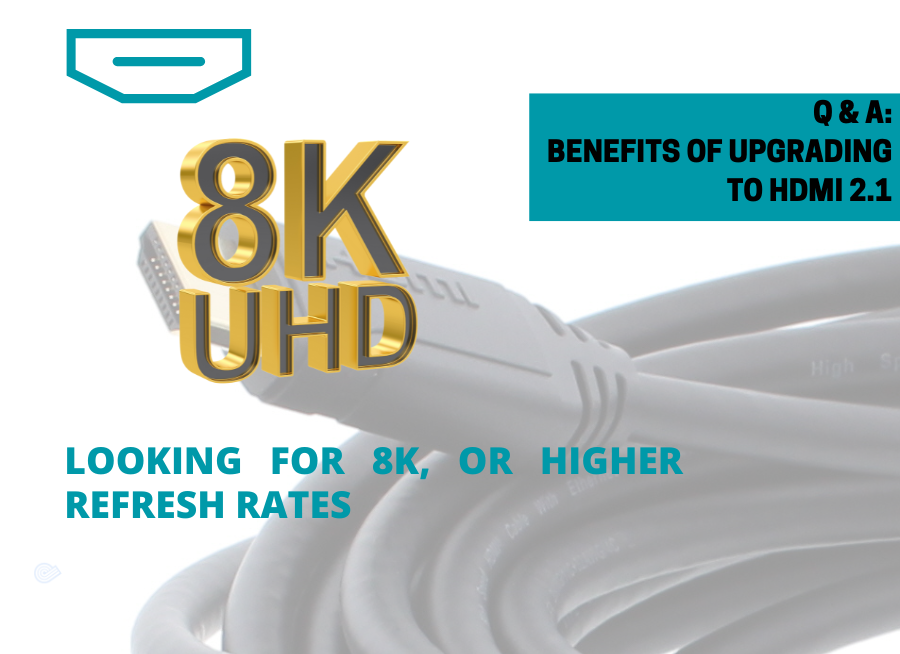Q&A: Exploring the Benefits of Upgrading to HDMI 2.1 Cables

Exploring the Benefits of Upgrading to HDMI 2.1 Cables: A Comprehensive Q&A Guide
In the ever-evolving landscape of technology, staying ahead of the curve is paramount for businesses aiming to optimise their operations. One such consideration for companies is upgrading their HDMI cables to the latest standard, HDMI 2.1, particularly in settings like conference rooms where visual clarity and fidelity play crucial roles. Let's delve into the key aspects of this upgrade and whether it aligns with your organisation's needs.
Key Features of HDMI 2.1
Compared to older HDMI iterations, HDMI 2.1 cables offer a suite of enhancements that can revolutionise your conference room display system. These include support for higher resolutions, such as staggering 8K, and elevated frame rates of up to 120 frames per second (fps). Moreover, HDMI 2.1 introduces advanced features like Variable Refresh Rate (VRR), Auto Low Latency Mode (ALLM), and Quick Media Switching (QMS), all of which contribute to an immersive viewing experience.
Resolution and Frame Rate Enhancement
The magic behind HDMI 2.1 lies in its ability to bolster resolution and frame rates through increased bandwidth and data transfer speeds. By accommodating higher pixel counts, HDMI 2.1 ensures images are sharper and more detailed, while its faster transfer speeds translate to smoother motion and reduced motion blur, especially during fast-paced sequences.
Enhanced Viewing Experience
Imagine your conference room presentations, videos, and graphics rendered with unparalleled clarity and realism. That's precisely the promise HDMI 2.1 brings to the table. With resolutions and frame rates pushed to their limits, your content becomes more lifelike, making it easier for viewers to discern details and seamlessly follow the proceedings.
Challenges and Considerations
Despite its promising features, upgrading to HDMI 2.1 isn't without its challenges. Compatibility issues with existing hardware, the necessity to upgrade other components like displays and source devices, and the associated costs of procuring new cables and equipment are factors that demand careful consideration.
Is It Worth the Investment?
Ultimately, the decision to upgrade hinges on a multitude of factors unique to your organisation. Conducting a thorough assessment of your budget, current display needs, and compatibility with existing hardware is imperative. Additionally, weigh the potential benefits of an enhanced viewing experience and future-proofing your conference room setup against the upfront investment required.

Q1: What are the main benefits of upgrading to HDMI 2.1 cables for our conference room display system?
A1: Upgrading to HDMI 2.1 cables offers several key benefits, including support for higher resolutions (up to 8K) and higher frame rates (up to 120 fps), as well as advanced features like Variable Refresh Rate (VRR), Auto Low Latency Mode (ALLM), and Quick Media Switching (QMS). These enhancements result in sharper, more detailed images and smoother motion, ultimately improving the overall viewing experience in your conference room.
Q2: How does HDMI 2.1 enhance resolution and frame rates?
A2: HDMI 2.1 enhances resolution by providing increased bandwidth, allowing for higher pixel counts and thus sharper, more detailed images. Similarly, it supports higher frame rates by offering greater data transfer speeds, resulting in smoother motion and reduced motion blur, especially in fast-paced scenes.
Q3: How can higher resolutions and frame rates improve the viewing experience in a conference room setting?
A3: Higher resolutions and frame rates offered by HDMI 2.1 cables can significantly enhance the viewing experience in a conference room setting. Presentations, videos, and graphics displayed on the conference room display will appear clearer, sharper, and more lifelike, making it easier for viewers to discern details and follow content seamlessly.
Q4: What challenges or limitations might we face when upgrading to HDMI 2.1 cables?
A4: Some potential challenges or limitations to consider when upgrading to HDMI 2.1 cables include compatibility issues with existing hardware, the need to upgrade other components such as displays and source devices to fully leverage HDMI 2.1 capabilities, and the cost associated with purchasing new cables and equipment.
Q5: Is upgrading to HDMI 2.1 cables worth the investment for our company?
A5: Whether upgrading to HDMI 2.1 cables is worth the investment depends on various factors such as your budget, current and future display needs, and compatibility with existing hardware. It's recommended that your company assesses its requirements, conducts thorough compatibility testing, and evaluates the cost-benefit ratio before making a decision. If significant benefits in terms of improved viewing experience and future-proofing your conference room setup are anticipated, then upgrading to HDMI 2.1 cables may be justified.
In conclusion, while upgrading to HDMI 2.1 represents a leap forward in display technology, its adoption should be a well-informed decision aligned with your organisation's objectives. By carefully evaluating the pros and cons, you can determine whether the benefits outweigh the costs and propel your conference room into the future of visual excellence.
Note: all resolutions and refresh-rates are dependent all equipment used within the installation.

